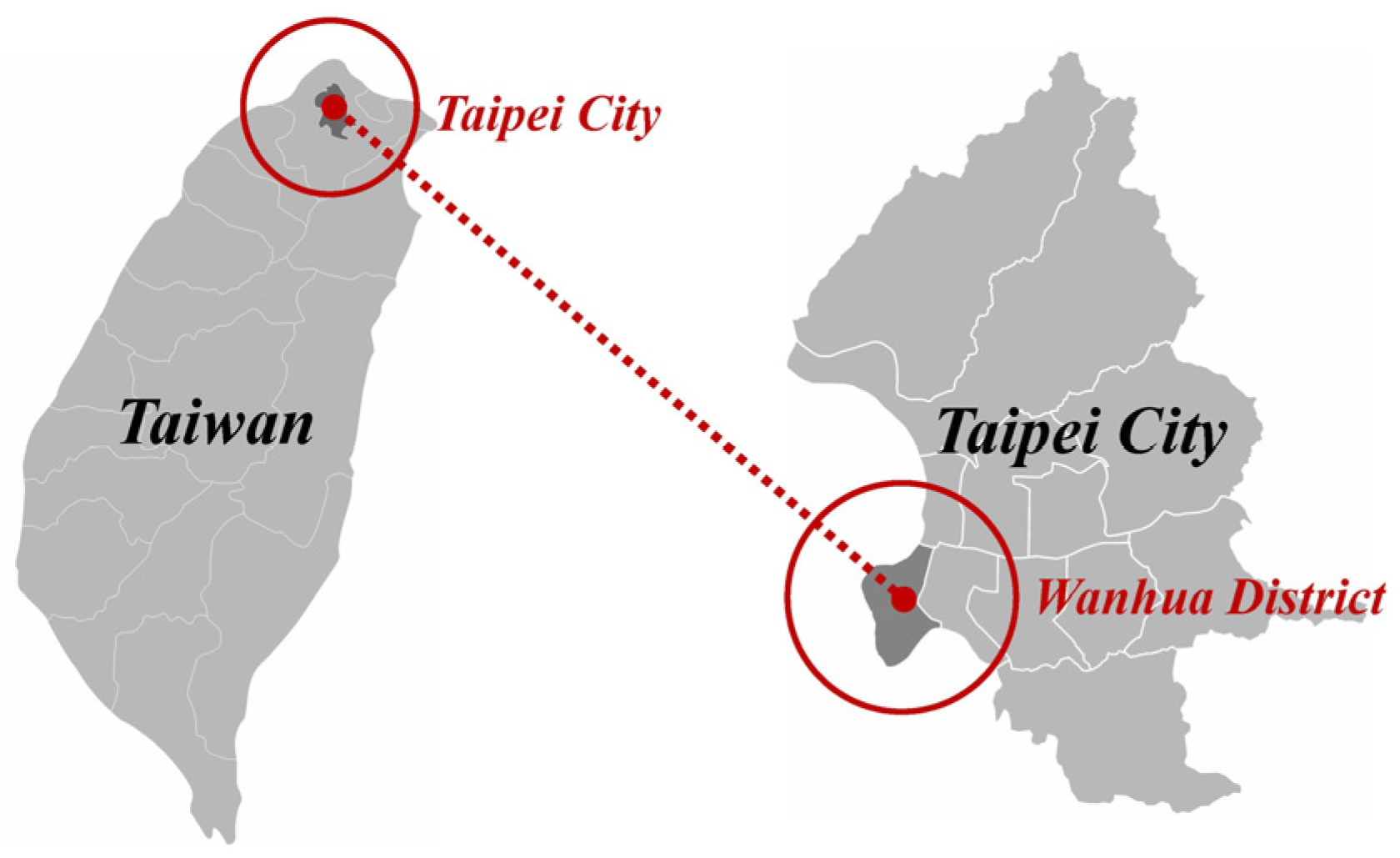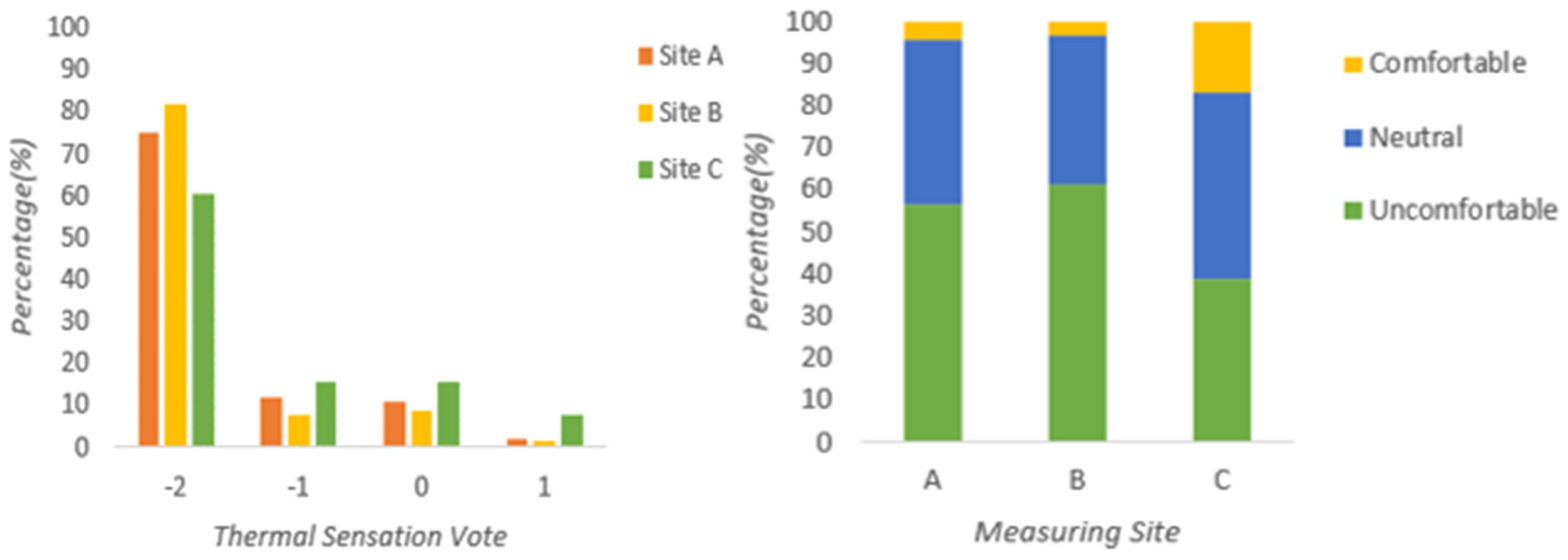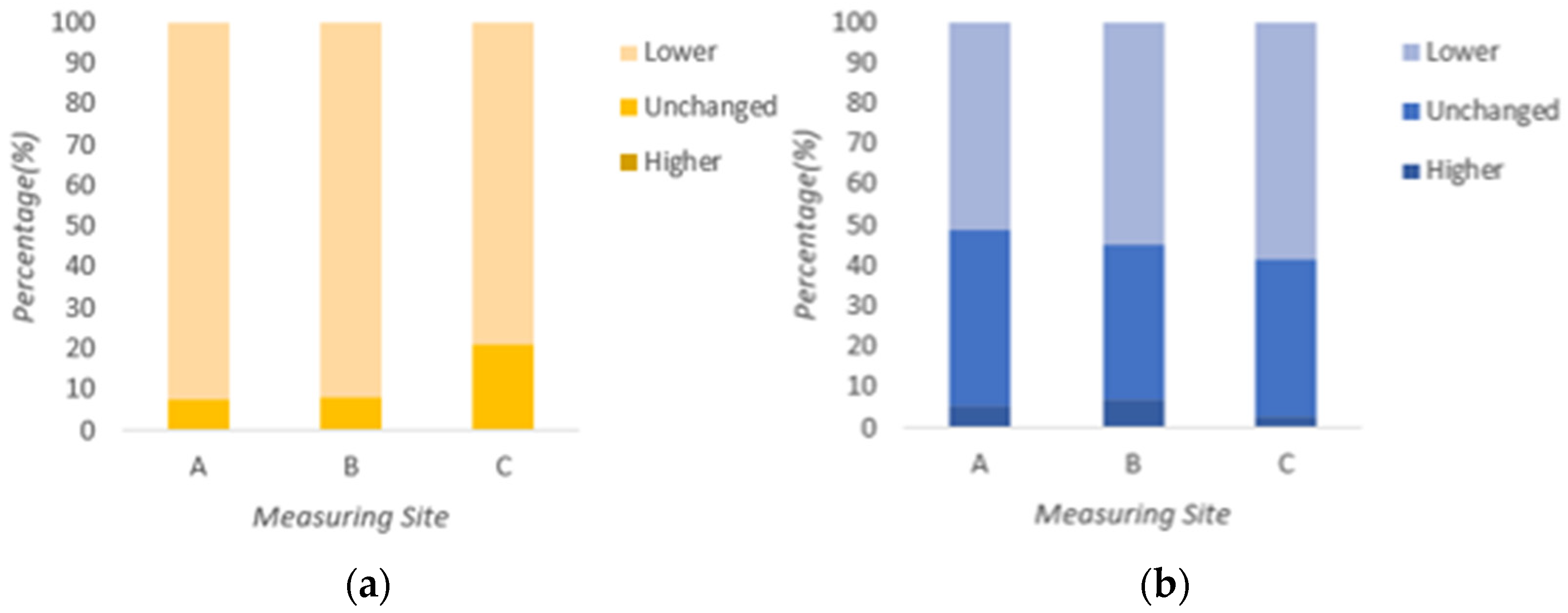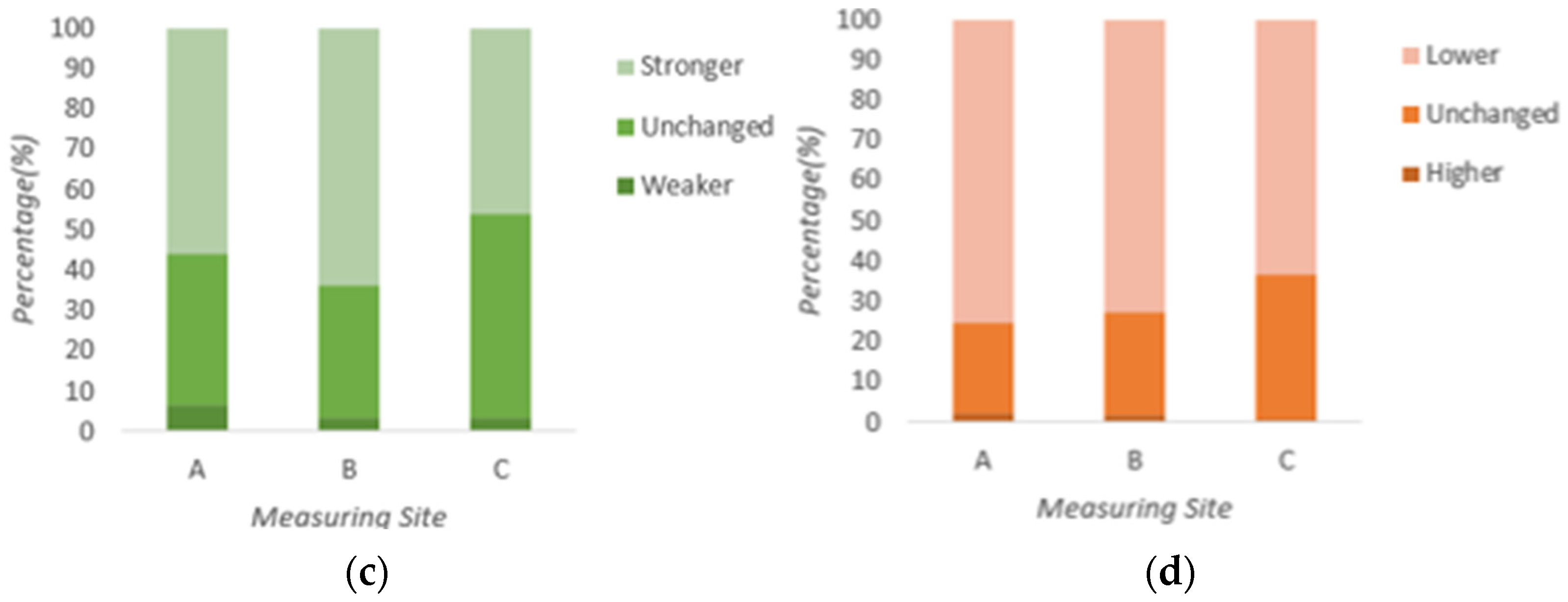Outdoor Thermal Comfort Study on Urban Areas with Various Densities in Taipei †
Abstract
:1. Introduction
2. Methodology
2.1. Experiment Site
2.2. Meteorological Measurement
2.3. Questionnaire Survey
2.4. Thermal Comfort Indices
3. Results and Discussions
3.1. Meteorological Measurement
3.2. Questionnaire Result
3.3. Relationship between Urban Densities and Pedestrian Thermal Comfort
3.3.1. Thermal Sensation Vote (TSV)
3.3.2. Meteorological Preferences Vote
3.3.3. Overall Thermal Comfort (OTC)
3.4. Thermal Comfort Indices
3.4.1. PET and UTCI Assessments
3.4.2. Linear Regression Analysis
4. Conclusions
Author Contributions
Funding
Institutional Review Board Statement
Informed Consent Statement
Data Availability Statement
Conflicts of Interest
References
- Hakim, A.A.; Petrovitch, H.; Burchfiel, C.M.; Ross, G.W.; Rodriguez, B.L.; White, L.R.; Yano, K.; Curb, J.D.; Abbott, R.D. Effects of Walking on Mortality among Nonsmoking Retired Men. N. Engl. J. Med. 1998, 338, 94–99. [Google Scholar] [CrossRef] [PubMed]
- Hass-Klau, C. Impact of pedestrianization and traffic calming on retailing: A review of the evidence from Germany. Transp. Policy 1993, 1, 21–31. [Google Scholar] [CrossRef]
- Jacobs, J. The Death and Life of Great American Cities; Penguin: Harmondsworth, UK, 1961. [Google Scholar]
- Kaplan, R.B.A.; Whyte, W.H. City: Rediscovering the Center. J. Arch. Educ. 1991, 44, 241. [Google Scholar] [CrossRef]
- Takano, T.; Nakamura, K.; Watanabe, M. Urban residential environments and senior citizens’ longevity in megacity areas: The importance of walkable green spaces. J. Epidemiol. Community Health 2002, 56, 913–918. [Google Scholar] [CrossRef] [Green Version]
- Liu, L.; Lin, Y.; Liu, J.; Wang, L.; Wang, D.; Shui, T.; Chen, X.; Wu, Q. Analysis of local-scale urban heat island charac-teristics using an integrated method of mobile measurement and GIS-based spatial interpolation. Build. Environ. 2017, 117, 191–207. [Google Scholar] [CrossRef]
- Xiong, J.; Lian, Z.; Zhou, X. Investigation of Subjectively Assessed Health Symptoms and Human Thermal Perceptions in Transient Thermal Environments. Procedia Eng. 2015, 121, 212–216. [Google Scholar] [CrossRef] [Green Version]
- Wang, Y.; Wang, A.; Zhai, J.; Tao, H.; Jiang, T.; Su, B.; Yang, J.; Wang, G.; Liu, Q.; Gao, C.; et al. Tens of thousands additional deaths annually in cities of China between 1.5 °C and 2.0 °C warming. Nat. Commun. 2019, 10, 3376–3377. [Google Scholar] [CrossRef] [Green Version]
- Zhang, L.; Wei, D.; Hou, Y.; Du, J.; Liu, Z.; Zhang, G.; Shi, L. Outdoor Thermal Comfort of Urban Park—A Case Study. Sustainability 2020, 12, 1961. [Google Scholar] [CrossRef] [Green Version]
- Huang, J.; Zhou, C.; Zhuo, Y.; Xu, L.; Jiang, Y. Outdoor thermal environments and activities in open space: An experiment study in humid subtropical climates. Build. Environ. 2016, 103, 238–249. [Google Scholar] [CrossRef] [Green Version]
- Cheung, P.K.; Jim, C. Comparing the cooling effects of a tree and a concrete shelter using PET and UTCI. Build. Environ. 2018, 130, 49–61. [Google Scholar] [CrossRef]
- Hu, T.; Yoshie, R. Effect of atmospheric stability on air pollutant concentration and its generalization for real and idealized urban block models based on field observation data and wind tunnel experiments. J. Wind. Eng. Ind. Aerodyn. 2020, 207, 104380. [Google Scholar] [CrossRef]
- Lai, D.; Liu, W.; Gan, T.; Liu, K.; Chen, Q. A review of mitigating strategies to improve the thermal environment and thermal comfort in urban outdoor spaces. Sci. Total Environ. 2019, 661, 337–353. [Google Scholar] [CrossRef] [PubMed]
- Wang, Y.; Akbari, H. Effect of Sky View Factor on Outdoor Temperature and Comfort in Montreal. Environ. Eng. Sci. 2014, 31, 272–287. [Google Scholar] [CrossRef]
- Berardi, U.; Wang, Y. The Effect of a Denser City over the Urban Microclimate: The Case of Toronto. Sustainability 2016, 8, 822. [Google Scholar] [CrossRef]
- Johansson, E. Influence of urban geometry on outdoor thermal comfort in a hot dry climate: A study in Fez, Morocco. Build. Environ. 2006, 41, 1326–1338. [Google Scholar] [CrossRef]
- Kakon, A.N.; Mishima, N.; Kojima, S. Simulation of the urban thermal comfort in a high density tropical city: Analysis of the proposed urban construction rules for Dhaka, Bangladesh. In Building Simulation; Springer: Berlin, Germany, 2009; Volume 2, pp. 291–305. [Google Scholar]
- Shih, W.-M.; Lin, T.-P.; Tan, N.-X.; Liu, M.-H. Long-term perceptions of outdoor thermal environments in an elementary school in a hot-humid climate. Int. J. Biometeorol. 2017, 61, 1657–1666. [Google Scholar] [CrossRef]
- Krüger, E.L.; Minella, F.O.; Rasia, F. Impact of urban geometry on outdoor thermal comfort and air quality from field measurements in Curitiba, Brazil. Build. Environ. 2011, 46, 621–634. [Google Scholar] [CrossRef]
- Mahmoud, A.H.A. Analysis of the microclimatic and human comfort conditions in an urban park in hot and arid regions. Build. Environ. 2011, 46, 2641–2656. [Google Scholar] [CrossRef]
- Matzarakis, A.; Rutz, F.; Mayer, H. Modelling radiation fluxes in simple and complex environments—Application of the RayMan model. Int. J. Biometeorol. 2007, 51, 323–334. [Google Scholar] [CrossRef]
- Matzarakis, A.; Rutz, F.; Mayer, H. Modelling radiation fluxes in simple and complex environments: Basics of the RayMan model. Int. J. Biometeorol. 2010, 54, 131–139. [Google Scholar] [CrossRef] [Green Version]
- Solovchenko, A.; Lukyanov, A.; Nikolenko, A.; Shurygin, B.; Akimov, M.; Gitelson, A. Physiological foundations of spectral imaging-based monitoring of apple fruit ripening. Acta Hortic. 2021, 1314, 419–428. [Google Scholar] [CrossRef]
- Matzarakis, A.; Gangwisch, M.; Fröhlich, D. RayMan and SkyHelios Model. Urban Microclim. Model. Comf. Energy Stud. 2021, 2021, 339–361. [Google Scholar] [CrossRef]
- Fröhlich, D.; Gangwisch, M.; Matzarakis, A. Effect of radiation and wind on thermal comfort in urban environ-ments—Application of the RayMan and SkyHelios model. Urban Clim. 2019, 27, 1–7. [Google Scholar] [CrossRef]







| Site A (Low Density) | Site B (Medium Density) | Site C (High Density) |
|---|---|---|
 |  |  |
| SVF = 0.287 | SVF = 0.140 | SVF = 0.114 |
| H/W = 1.3 | H/W = 2.75 | H/W = 6.88 |
| Site | SVF | Tg (°C) | Ta (°C) | RH (%) | v (m/s) | ||||||||
|---|---|---|---|---|---|---|---|---|---|---|---|---|---|
| Mean | Max. | Min. | Mean | Max. | Min. | Mean | Max. | Min. | Mean | Max. | Min. | ||
| A | 0.287 | 37.9 | 42.3 | 34.4 | 36.5 | 39.5 | 33.0 | 47.1 | 56.1 | 40.9 | 0.9 | 3.8 | 0.1 |
| B | 0.14 | 37.2 | 40.0 | 33.8 | 36.7 | 39.5 | 34.4 | 45.7 | 53.0 | 39.9 | 0.7 | 2.6 | 0.1 |
| C | 0.114 | 36.1 | 43.1 | 32.5 | 35.7 | 38.2 | 33.1 | 47.7 | 57.1 | 41.1 | 1.5 | 5.8 | 0.2 |
| Site | Gender | No. of Subjects | Avg. Clothing (clo) | Avg. Metabolism (met) | |
|---|---|---|---|---|---|
| A | M | 208 | 457 | 0.28 | 2.03 |
| F | 249 | ||||
| B | M | 178 | 384 | 0.28 | 2.11 |
| F | 206 | ||||
| C | M | 155 | 336 | 0.29 | 2.06 |
| F | 181 | ||||
| Age Range | <12 | 13–18 | 19–30 | 31–40 | 41–50 | 51–60 | 61–65 | 65< | Total |
| No. of Subjects | 33 | 163 | 539 | 123 | 111 | 100 | 41 | 67 | 1177 |
| Percentage (%) | 2.8 | 13.8 | 45.8 | 10.5 | 9.4 | 8.5 | 3.5 | 5.7 | 100.0 |
| No. | Question | Variable | Option | Statistics and Percentage | |||||
|---|---|---|---|---|---|---|---|---|---|
| A | B | C | |||||||
| 1 | How do you feel? | TSV | Hot = −2 | 344 | 75.3% | 315 | 82.0% | 204 | 60.7% |
| Warm = −1 | 55 | 12.0% | 30 | 7.8% | 53 | 15.8% | |||
| Neutral = 0 | 49 | 10.7% | 34 | 8.9% | 53 | 15.8% | |||
| Cool = +1 | 9 | 2.0% | 5 | 1.3% | 26 | 7.7% | |||
| Cold = +2 | 0 | 0.0% | 0 | 0.0% | 0 | 0.0% | |||
| 2 | How would you prefer the air temperature to be? | Ta preference | Higher = −1 | 2 | 0.4% | 0 | 0.0% | 1 | 0.3% |
| Unchanged = 0 | 33 | 7.2% | 31 | 8.1% | 70 | 20.8% | |||
| Lower = +1 | 422 | 92.3% | 353 | 91.9% | 265 | 78.9% | |||
| 3 | How would you prefer the relative humidity to be? | RH preference | Higher = −1 | 25 | 5.5% | 27 | 7.0% | 9 | 2.7% |
| Unchanged = 0 | 199 | 43.5% | 146 | 38.0% | 131 | 39.0% | |||
| Lower = +1 | 233 | 51.0% | 211 | 55.0% | 196 | 58.3% | |||
| 4 | How would you prefer the wind speed to be? | v preference | Weaker = −1 | 30 | 6.6% | 14 | 3.7% | 12 | 3.6% |
| Unchanged = 0 | 171 | 37.4% | 126 | 32.8% | 169 | 50.3% | |||
| Stronger = +1 | 256 | 56.0% | 244 | 63.5% | 155 | 46.1% | |||
| 5 | How would you prefer the solar radiation to be? | Sun exposure preference | Higher = −1 | 11 | 2.4% | 7 | 1.8% | 3 | 0.9% |
| Unchanged = 0 | 103 | 22.5% | 99 | 25.8% | 121 | 36.0% | |||
| Lower = +1 | 343 | 75.1% | 278 | 72.4% | 212 | 63.1% | |||
| 6 | How is your overall thermal comfort? | Thermal Comfort | Uncomfortable = −1 | 259 | 56.7% | 236 | 61.5% | 130 | 38.7% |
| Neutral = 0 | 178 | 38.9% | 135 | 35.1% | 149 | 44.3% | |||
| Comfortable = +1 | 20 | 4.4% | 13 | 3.4% | 57 | 17.0% | |||
| Site | 10:00−12:30 | 13:00−15:30 | 15:30−18:00 | Average | ||||||||
|---|---|---|---|---|---|---|---|---|---|---|---|---|
| Tmrt | PET | UTCI | Tmrt | PET | UTCI | Tmrt | PET | UTCI | Tmrt | PET | UTCI | |
| A | 47.9 | 42.4 | 39.9 | 50.7 | 45.6 | 42.4 | 39.7 | 38.8 | 38.5 | 46.1 | 42.2 | 40.3 |
| B | 46.8 | 42.9 | 40.6 | 45.2 | 42.3 | 40.6 | 38.8 | 38.1 | 38.1 | 43.6 | 41.1 | 39.8 |
| C | 44.7 | 39.7 | 38.3 | 44.0 | 40.3 | 39.1 | 38.0 | 36.9 | 36.8 | 42.3 | 38.9 | 38.0 |
Disclaimer/Publisher’s Note: The statements, opinions and data contained in all publications are solely those of the individual author(s) and contributor(s) and not of MDPI and/or the editor(s). MDPI and/or the editor(s) disclaim responsibility for any injury to people or property resulting from any ideas, methods, instructions or products referred to in the content. |
© 2023 by the authors. Licensee MDPI, Basel, Switzerland. This article is an open access article distributed under the terms and conditions of the Creative Commons Attribution (CC BY) license (https://creativecommons.org/licenses/by/4.0/).
Share and Cite
Su, Y.-M.; Antoni, J. Outdoor Thermal Comfort Study on Urban Areas with Various Densities in Taipei. Eng. Proc. 2023, 38, 77. https://doi.org/10.3390/engproc2023038077
Su Y-M, Antoni J. Outdoor Thermal Comfort Study on Urban Areas with Various Densities in Taipei. Engineering Proceedings. 2023; 38(1):77. https://doi.org/10.3390/engproc2023038077
Chicago/Turabian StyleSu, Ying-Ming, and Janmichael Antoni. 2023. "Outdoor Thermal Comfort Study on Urban Areas with Various Densities in Taipei" Engineering Proceedings 38, no. 1: 77. https://doi.org/10.3390/engproc2023038077






